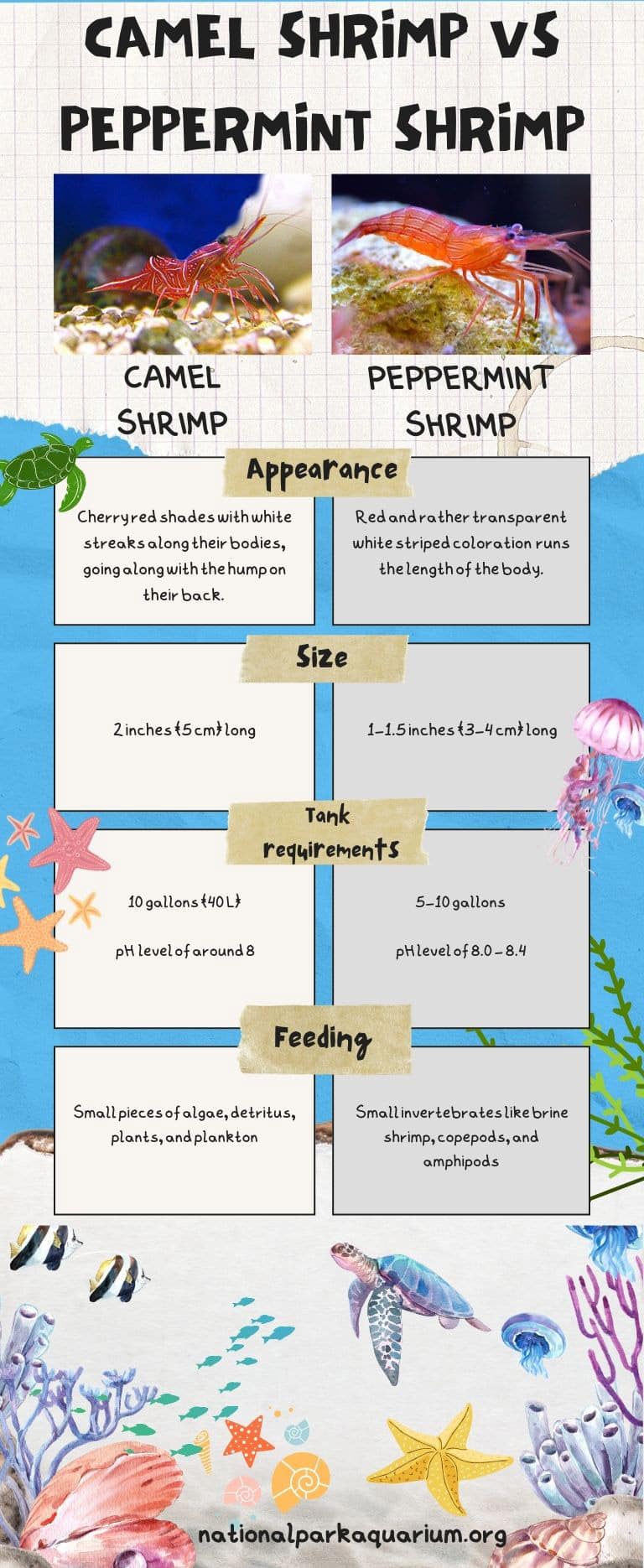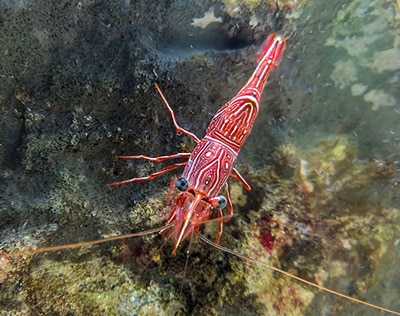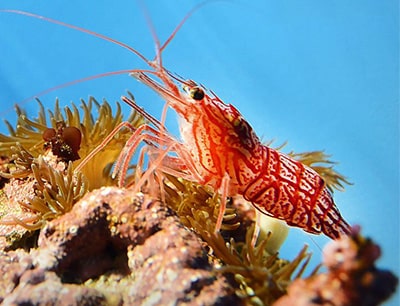Camel shrimp and Peppermint shrimps are both great additions to diverse tank life. Indeed, many do not seem to differentiate between the two, mostly because they both look vicious in red hues.
Let’s clear all the confusion with the detailed descriptions of both shrimps below. You can make your choice after reading about their features and benefits. Just know that Peppermint shrimp is a tank cleaner while Camel shrimp is not.
Camel shrimp vs Peppermint shrimp

1. Coloration/Patterns
Peppermint shrimp are easily identified by their red and rather transparent white striped coloration. These stripes run the length of the body and continue onto the tails. The red and white colors act as camouflage, helping the shrimp blend in with the anemones and corals they associate with the wild.
Camel shrimps’ coloration is quite distinct as their cherry red shades are more accent than peppermint shrimps. Furthermore, they have these white streaks along their bodies, going along with the hump on their back. So, it’s easy to notice these shrimps, which are often called Camelback because of the hump looking like Camel.
2. Life Span/Size
The average lifespan for a camel shrimp is 1-2 years, but some have been known to live up to 4 years in captivity. On average, these shrimps grow to be about 2 inches (5 cm) long.
Peppermint shrimp have a lifespan of 1-2 years in captivity. On average, they grow to be about 1-1.5 inches (3-4 cm) long.
3. Breeding/Reproduction
Camel shrimp reproduce by releasing eggs into the water, where the male fertilizes them. It’s rather tricky to breed these shrimps in your aquarium. The female shrimps lay around 100 – 600 eggs, incubating for about two weeks.
Peppermint shrimp breed readily in captivity if given the proper conditions. They are hermaphroditic, thus making breeding rather easy.
4. Care level/Tank requirements
Camel shrimp are easy to care for and make a great addition to any saltwater aquarium. They are peaceful creatures that do well in both reef and fish-only tanks.
These shrimps require a tank of at least 10 gallons (40 L) with plenty of hiding places.
The ideal temperature to care for these shrimps is 70 – 80 °F. They require a pH level of around 8, with a nitritrate level below 20 ppm.
Peppermint shrimp are also easy to care for, as they are peaceful creatures. These shrimps require a tank of at least 5-10 gallons with plenty of hiding places.
They will be comfortable in tank water with a pH level of 8.0 – 8.4. The ideal temperature range for them is 65 – 73 °F
5. Diet/Feeding
Camel shrimp are scavengers that will eat just about anything they can find. Their diet consists of small pieces of algae, detritus, plants, and plankton. They are opportunistic feeders who will also take advantage of leftovers that other scavengers don’t want to eat.
Peppermint shrimp are known for their ability to clean up unwanted pests in your aquarium. Their diet consists mainly of small invertebrates like brine shrimp, copepods, and amphipods. They will also eat algae and detritus.
Which Species Would Be Better Suited for Your Aquarium?


If you’re looking for a colorful, hardy shrimp to add to your aquarium, then the camel shrimp and peppermint shrimp may be good species to consider.
But which one is better suited for your tank?
Both types of shrimp are relatively easy to care for and can be kept in a wide range of aquarium setups.
For starters, camel shrimp are more delicate than peppermint shrimp and require more careful handling.
They are also more sensitive to water quality and temperature changes, so it’s important to keep a close eye on your aquarium parameters if you add them to your tank.
In addition, camel shrimp are less active than peppermint shrimp and tend to spend most of their time hiding in the substrate or amongst live plants.
On the other hand, peppermint shrimp are hardier than camel shrimp. They can tolerate a wide range of water parameters and tank conditions.
They are also very active and will spend most of their time roaming around the tank, scavenging for leftover food or algae to eat.
Suppose you are looking for an algae-eating shrimp that can also serve as a predator to other small invertebrates in your tank. In that case, the peppermint shrimp might be the best choice.
However, suppose you are more interested in observing filter-feeding behaviors or simply want a more colorful addition to your tank. In that case, the camel shrimp might be the way to go.
Conclusion
So, what’s the verdict? Is camel shrimp better than peppermint shrimp? In a word – no. Camel shrimp vs peppermint shrimp, whether you choose will depend on your individual preferences and what kind of care you have available to you in your aquarium setup.
Whichever species you decide on, be sure to provide them with plenty of hiding spots so that they can feel safe and secure in their new home.




